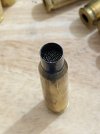Mike Matteson
Well-Known Member
That's the way I understand it and do it with new brass. Fired brass I size and use a mandrel to push the uneveness to the outside then cut to length. Then cut for thickness.I appreciate your argument. No hostility taken. For the described procedure I am using a standard 338LM chamber. I had turned the necks to fit a custom chamber such that the wall thickness is 0.012" so that means the final narrowing of the neck has to be about 0.002" tighter. I have a custom honed FL sizer without an expander ball to get to the correct internal diameter. This procedure should apply to 0.014" thick necks as well. If you do any neck turning, it should be done before any resizing preferably on once fired brass.
It's take me 4 steps to necks down from 7mm to 6mm. I cut for thickness in 2 setups. Step down twice, anneal and finish up. So far I' ve been able to acheive tension at the time. The Smith want a few case to test fire. Found my neck is a little smaller ID than want by .0005. So I am cutting the thckness to .00125. Smith moved his shop, and I didn't have the blank to chamber for the seating die. I have a Gen-3 for length, and a 21st ctr to cut the thickness.
It's kind of been one delay after another here as of late. Looks like I am good to go! Live and learn. Thanks again.


